 Happy Tuesday, everyone! If you have some online time on your hands today, come and visit me at the eHarlequin forums. I’ll be talking about the “Muses” all week this week (book 2 of the trilogy, To Deceive a Duke, will be on the shelves in May, and next Tuesday I’ll be here talking about it and giving a copy away!). And I found out that, due to a snafu, the ebook of Countess of Scandal will finally be out on April 30. Yay!
Happy Tuesday, everyone! If you have some online time on your hands today, come and visit me at the eHarlequin forums. I’ll be talking about the “Muses” all week this week (book 2 of the trilogy, To Deceive a Duke, will be on the shelves in May, and next Tuesday I’ll be here talking about it and giving a copy away!). And I found out that, due to a snafu, the ebook of Countess of Scandal will finally be out on April 30. Yay!
Now, last week I blogged about Handel’s Messiah and its big premier in Dublin. This week marks another anniversary for Handel–the date he was interred at Westminster Abbey in 1759. I have one great enjoyment in life that strangely enough I have found non-history geeks and non-history readers think is a bit odd. I enjoy wandering around old cemeteries. I like reading the epitaphs and imagining how the people lived, I like deciphering antique symbols, and I even like visiting the resting places of historic figures I admire. I guess I think that by some kind of osmosis I can communicate with them (though that has never happened, and would scare the bezeesus out of me if it did)! There is no better cemetery for a history buff than Westminster Abbey. It’s full of the great, near-great, famous, and people who just somehow had the pull to get themselves big tombs there when they died but no one knows them now. There are royals galore, scientists, artists of all sorts, politicans, all sorts.
On the Splendors of the Regency tour Diane and I went on a few years ago, we got to go to the Abbey (not as part of the tour, just as something to keep us busy when we first got there). Despite a torrential rainstorm as we tried to leave and my jet-lagged daze, it was an amazing experience just to wander around and find people I “knew” as well as look at the sites I remembered from royal wedding and coronation videos. I stood on top of the marker where Cromwell once was (before Charles II dug him up and hanged him), and cried at the elaborate tomb of Elizabeth I. Here are just a few of the luminaries you can see there:
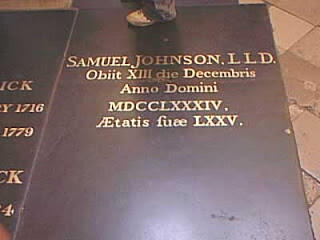 Samuel Johnson, d. 1784 (who happens to be right next to Ben Jonson, d. 1637, and actor David Garrick, d. 1779)
Samuel Johnson, d. 1784 (who happens to be right next to Ben Jonson, d. 1637, and actor David Garrick, d. 1779)
 Henry Purcell (d. 1695) and his wife Francisca
Henry Purcell (d. 1695) and his wife Francisca
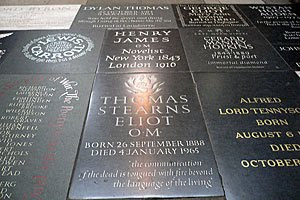 Poets’ Corner, where you can find everyone from Chaucer to Olivier, and memorials to many who are buried elsewhere like Shakespeare and Eliot (it’s quite crowded there)
Poets’ Corner, where you can find everyone from Chaucer to Olivier, and memorials to many who are buried elsewhere like Shakespeare and Eliot (it’s quite crowded there)
 Explorer David Livingstone (d. 1873)
Explorer David Livingstone (d. 1873)
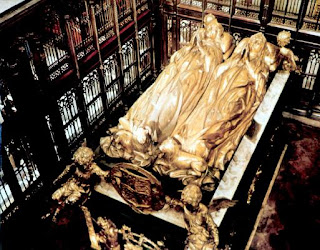 Henry VII and his queen Elizabeth of York (in, appropriately, the Henry VII Chapel)
Henry VII and his queen Elizabeth of York (in, appropriately, the Henry VII Chapel)
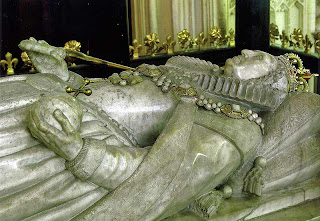 Also in the Henry VII Chapel, his granddaughter Elizabeth I (and Mary I, too, but only Elizabeth gets an effigy)
Also in the Henry VII Chapel, his granddaughter Elizabeth I (and Mary I, too, but only Elizabeth gets an effigy)
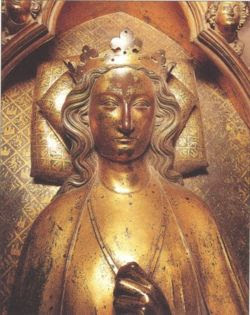 Eleanor of Castile, d. 1290 (I just think this effigy is so beautiful)
Eleanor of Castile, d. 1290 (I just think this effigy is so beautiful)
 Anne of Cleves, the only wife of Henry VIII to be buried at Westminster (d. 1557)
Anne of Cleves, the only wife of Henry VIII to be buried at Westminster (d. 1557)
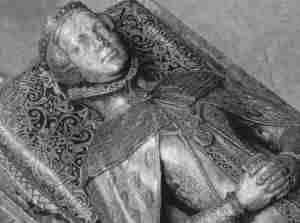 Frances Brandon Grey, Duchess of Suffolk, mother of the unfortunate Jane Grey (her youngest daughter Mary is buried with her)
Frances Brandon Grey, Duchess of Suffolk, mother of the unfortunate Jane Grey (her youngest daughter Mary is buried with her)
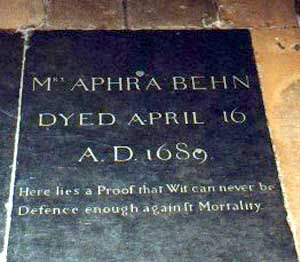 Playwright Aphra Behn (d. 1689). Proof that wit can never be defense against mortality.
Playwright Aphra Behn (d. 1689). Proof that wit can never be defense against mortality.

Margaret Beaufort, mother of Henry VII
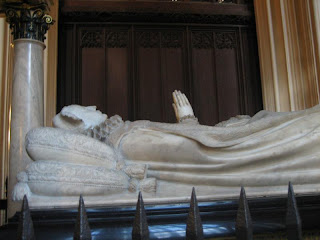 She is right next to her great-granddaughter Mary, Queen of Scots, who has one of the biggest tombs in the place (put up by her son when he became James I)
She is right next to her great-granddaughter Mary, Queen of Scots, who has one of the biggest tombs in the place (put up by her son when he became James I)
 And Elizabeth, Duchess of Northumberland, a famous hostess of her day who died in 1776–I think it’s so gorgeous!
And Elizabeth, Duchess of Northumberland, a famous hostess of her day who died in 1776–I think it’s so gorgeous!
This is just the tiniest tip of the iceberg to the sites found in the Abbey. Have you been there? What are some of your favorites? And if you share my historical hobby, what are some great historical cemeteries you’ve visited?


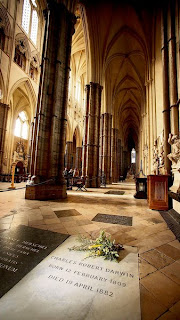
Amanda, you should check out Sarah Stewart Taylor’s mystery series. It’s about graves, Victorian graves, but still pretty cool. While I lived in the UK I had a friend who was doing her thesis on Victorian death rituals and we visited a lot of cemeteries and did a lot of grave rubbings. The marker that stood out the most to me is Dylan Thomas’ which is just a thin wooden cross, which needs to be replaced every year because the weather destroys it.
I could look at those pictures for hours. WOW. Thank you for a treat I would never have considered. Will definitely add things to my list for my next trip to Enland (if the planes ever fly again).
Oh, I remember that day, Amanda! I was overwhelmed at Westminster. Here I was, jet-lagged, in England for the first time, in a church I’d never thought much about, except for the song, “Winchester Cathedral…you’re bringing me down…you stood and you watched as..my baby left town.” I wasn’t at all prepared for what we saw there.
I must go back!
A couple of years ago we visited the graveyard in the small Tennessee town where my husband’s father came from. It was facinating, with its Civil War (Yankees, too, which was a surprise to me) and pre-Civil War.
I’ve been to both Westminster Abbey and St Paul’s. The latter is the most beautiful building I’ve ever been in, and, of course, Nelson and Wellington are buried there. Though when I was there, almost 15 years ago now, I was only beginning to be seriously interested in the Regency era, and by the time we got to the crypt it was getting close to time to leave, so I only have the vaguest memory of glancing at Nelson’s crypt, and the pictures of Wellington’s don’t look familiar to me at all.
I also love old cemeteries in general. A few years ago, about six months after my father died, my husband and I went to the cemetery most of my family is buried in to see my father’s gravestone. We went there first, of course, but then spent two hours on a chilly December day wandering, tracing all the history we could find in one tiny rural cemetery that has been in continual use since 1825 or so. The oldest DOB we found was 1789, but some of the oldest stones were weathered into illegibility. I calculated I was some kind of relative to at least half the people buried there.
If nothing else, an old cemetery like that will make you grateful for vaccination and modern medicine. So many tiny graves, right up into the first few decades of the 20th century.
I thought I wanted to be cremated and stuck in a tacky jar when the time comes but now I’ve changed my mind. I want a big old mausoleum AND and effigy.
Thank you, Ammanda.
Amanda, thanks for a trip down memory lane! I have visited Westminster Abbey four times and found someone new each trip!
You would enjoy a visit to Westminster’s cousin, Dunferline Abbey in Fife. Dunferline is second only to Iona as the final resting place for Scottish kings. Dunferline was damaged first by King Edward of England in 1303 and during the Reformation in 1560. It fell out of Royal Favor as the Scottish King James VI became the English King James I and moved his court to London. But Scotland’s most revered king, Robert the Bruce, was buried in Dunferline Abbey in 1329. As the centuries passed, the exact spot became obscure. In 1818 building work started on the new Abbey Church and workmen came across a vault that contained the King’s remains. He was carefully re-interred under the pulpit. In 1889, Lord Elgin commissioned a brass replica of a medieval memorial for his descendent. The bell tower was also rebuilt with a rectangular “crown” spelling out “King-Robert-the-Bruce”.
Amanda, the timing of your post is just too eerily perfect because last night my book club visited the grave of F. Scott Fitzgerald.
Fitzgerald’s grave (Zelda is buried with him) is in a small Catholic cemetery in Rockville, Maryland (a suburb of Washington, DC). Despite it being so close, none of us had gone there before. We decided to meet there when we picked “The Great Gatsby” for our April book, and, as it turns out, carved on the burial stone is the book’s famous last line: “So we beat on, boats against the current, borne back ceaselessly into the past.” Seeing his grave after having just read the book was immeasurably poignant.
I’ve visited Westminster, too, a long time ago, and was totally struck by its majesty. I liked seeing the effigies of people I’d read about. Thanks for sharing the pix.
Amanda, I’ve been to Westminster Abbey many times, but there were some graves you photographed that I’ve never seen. Another reason to go back! My favorite tomb in the Abbey is that of Henry V and Catherine of Valois. I’ve been to Highgate but you can’t seen the graves of the Rossetti’s because they haven’t been kept up. My other favorite cemetary is Green-Wood cemetery in Brooklyn where Lola Montez, Albert Anastasia, and Henry Ward Beecher are buried.
Thanks for a great trip down memory lane, Amanda. I have visited Westminster both as a very young girl and as a college student. I was obsessed with Elizabeth I as a young girl and I do remember how in awe I was to visit her tomb. Then as a college student Handel’s grave was the one that moved me to tears. His music has done so much for me. It literally changed my life. I had given up on singing when I auditioned for the solo – Rejoice greatly, O daughter of Zion (at my husband’s insistence) for the community college at the University of Southern Mississippi. A professor of voice heard the audition and insisted I come to visit her studio the next day. By the end of the week I was enrolled in graduate school, had a TA position and a scholarship and the rest is history.
I think the most poignant grave I have ever visited was the one in Vienna’s St. Marx’s cemetery where the weeping angel cries over a multiple burial plot where Mozart’s body is supposedly buried. They don’t know the exact spot. I compare it to Beethoven’s grave which is far larger and more elaborate.
I must confess I love to visit old cemeteries and cathedrals and peruse the markers, tombs and effigies. I don’t know why, but there is something rather comforting about it.
I’m very glad to see I’m not the only one who enjoys old cemeteries and churches!!! Makes me feel much less weird. 🙂
Diane, I was very overwhelmed that day too, so I know I missed a lot of things I would love to see! I guess it’s just an excuse to go back. 🙂 (I want to visit St. Paul’s next time too, and travel to Winchester to visit Jane Austen…). I remember we also visited Salisbury Cathedral, but it was such a hurried stop I missed a lot of people with tombs there.
Jane Austen (not the one at Winchester, the one here!!), I love the Taylor mysteries! My favorite was one that centered around an exhibit of mourning jewelry (though I can’t remember the title)
Susanna, I agree that old burial plots can make us very grateful to live in modern times! My own grandparents are buried in a fairly new cemetery (the oldest sites date back just to the 1880s and ’90s, though some of them are beautiful, aboveground New Orleans-style mausoleums). My grandmother lost a baby soon after birth in the 1940s and the section where he is buried is filled with tiny markers, so sad.
Carolyn, LOL! Me too. I want a huge marble thing with angels and weeping Grecian figures and big long poems. 🙂
Kim, I am putting Dunferline on my “things to see” list
Elizabeth, a few of the pics are mine and a few are scanned from postcards (I wasn’t allowed to take a photo of Elizabeth I’s tomb for instance), but from looking around online I found enough interesting tombs to make a post days long! So many people to look for next time I’m there.
BTW, I think one of the loveliest and eeriest of tombs is that of Marian Adams, wife of Henry Adams, who committed suicide in 1886 and is buried in Rock Creek Cemetery in Washington. Her husband commissioned the famous sculptor Saint-Gaudens to do her tomb effigy. Here’s a link to more info on it http://www.quidplura.com/?p=43
Great post, Amanda!
I find graves interesting too, and if you know some Latin you can entertain yourself in a church with translations if it’s raining outside.
That would make a great scene between h/h Janet!
I agree with Jane, Janet! A great scene (though I know almost no Latin, it’s also fun to make up what the inscriptions might be, LOL)
I loved this post. I’ve never been there but through your pictures I found it a very exciting experience.. Thank you. It must be very exciting being there and emotional as well.
Carol L.
More thoughts:
Years ago I happened on an exhibit of headstones in NYC. By far the most poignant was one from a young husband over his wife’s grave: “I know my tears cannot bring her back, therefore I weep.” That exhibit was many years ago and I still haven’t seen another inscription to match it in packing so much emotion into such a brief statement.
Also, re Henry and Clover Adams, I think I read somewhere that he doesn’t even mention her in his autobiography. Perhaps someone who’s actually read the book could confirm/deny. Seems awfully cold to me, if true, although it may be a sign of the exact opposite: it was just too painful and too personal to put into print for public consumption.
Ah…great fodder for my upcoming trip, Ammanda.